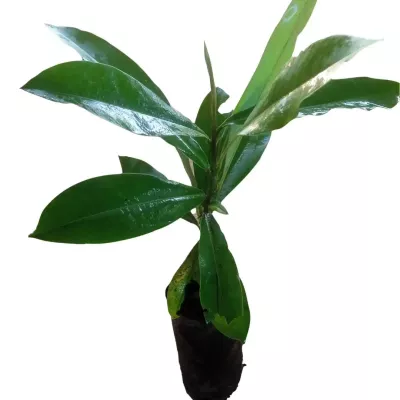



Velvet apple tree is cultivated for its fruit and wood, most commonly as a backyard tree, and it is also frequently used as a shade tree along the sides of roads. It is also grown as an ornamental tree because of its attractive leaves and fruit.

Pay using UPI, Card or Netbanking

Shipping within 3 working days
Velvet persimmon, botanically Diospyros blancoi (syn. Diospyros discolor), is a species of the Ebenaceae family, known in English as the velvet apple".
The velvet apple is native to the Philippines, where it's called mabolo, meaning hairy. The skin has a velvety texture, hence the name velvet apple.
It's a tropical fruit tree that grows well in India.
The edible fruits are highly prized in some areas but are unknown in most of the world.
The velvet persimon is known for its dense evergreen foliage and round crown that can grow up to 15 metres tall. The mabolo tree thrives in warm and humid climates and prefers well-drained soil and full sun.
When you plant a velvet apple, you should keep a distance of 8 to 10 metres. The tree needs minimal pruning, but it'll benefit from light pruning to remove dead or damaged branches. The plant has a strong root system.
The velvet apple tree needs regular watering, especially during the first growth phase. Once it has established itself, it can tolerate some drought. The tree is relatively low-maintenance, but it benefits from periodic fertilization with vermicompost or any other balanced fertilizer.
The fruit of Diospyros blancoi is a spherical berry 5 to 8 centimetres in diameter. The skin of the velvet persimon is fluffy and velvety and has a greenish-brown or dark brown colour. The 'flesh is white, soft and juicy, with a sweet and aromatic taste. The fruit is usually eaten fresh or used in desserts, jams and jellies. The fruit is also used in traditional medicine to treat digestive problems and as a general health tonic.
The velvet apple is a good source of fibre, vitamin C and potassium. It also contains antioxidants and has anti-inflammatory properties.
The tree is prized for its durable and hard wood, which is used for furniture, carvings and other woodworking projects.
The 'velvety skin of the fruit is so soft that it has been compared to the skin of a peach'.
The velvet apple is a popular ornamental plant valued for its attractive foliage and fruit. The tree is an important part of the traditional medicine of many Southeast Asian countries.
Data sheet